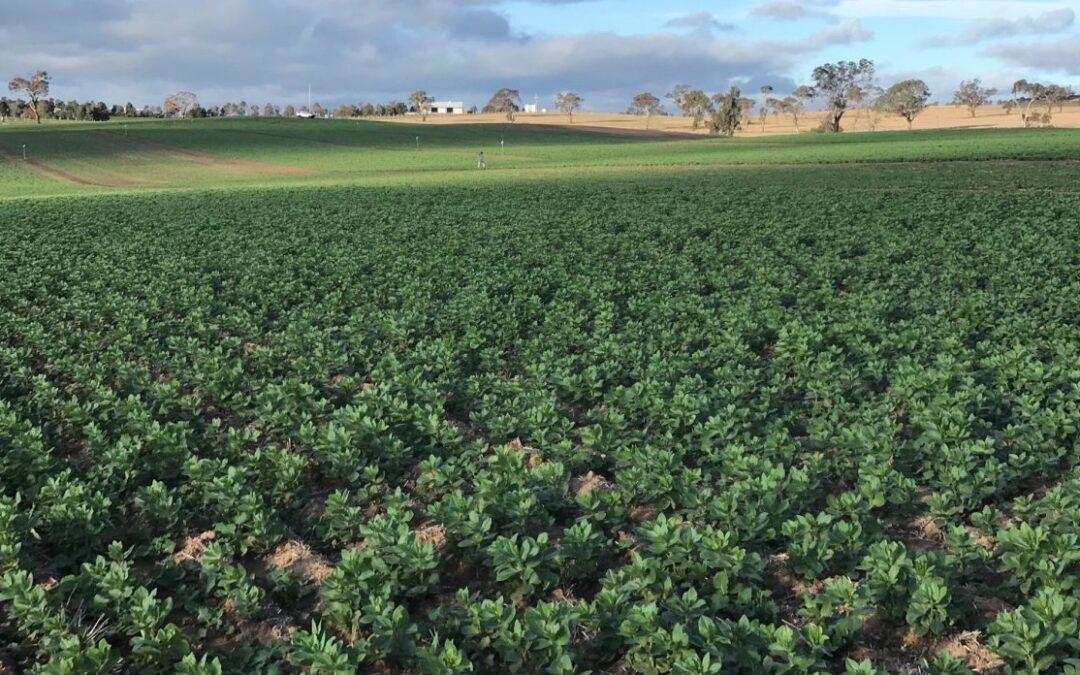PROSPECTS for a bumper pulse crop across southern Australia are weighing on bids in a thinly-traded market as bulk cargoes of faba beans and lentils booked in earlier trades continue to load.
In the north, the start of the chickpea harvest is fast approaching, and a spring-planted mungbean crop with potential for a record area is already going in the ground.
Localised flooding in parts of New South Wales is of concern for low-lying crops but conditions in all other areas are seen as above average to ideal.
All prices quoted are in Australian dollars per tonne unless otherwise indicated.
Chickpeas
Chickpea prices have firmed marginally in the past month to reflect volume buying from Pakistan, and market realisation that Australia’s new crop will be a fraction the size of 2021-22 production.
Last month, chickpeas with minor weather damage were trading at $400-$420 per tonne delivered up-country container packer, and prices are consolidating at around $420-$425/t in the prompt market.
Current-crop chickpeas are being shipped in bulk from Central Queensland (CQ) ports to Pakistan, and this is clearing stocks of higher-quality chickpeas ahead of new crop.
“The Pakistan market is getting firmer, and demand is there because stock is required,” Wilson International Trade director Peter Wilson said.
Recent flooding in Pakistan has bolstered the demand for prompt deliveries of this dietary staple.
“The government is doing its best for displaced people.”
Harvest in Central Queensland (CQ) is expected to start in the next three weeks or so, roughly two weeks later than normal due to delayed planting and an unusually mild and wet growing season.
Bangladesh is expected to step into the market for new-crop bulk shipments if it hasn’t already.
Faba beans
Faba beans delivered port are trading at $390/t, unchanged from last month.
Mr Wilson said financial difficulties for its importers have hampered Egypt’s interest in buying Australian faba beans.
“The only market buying is Egypt, and payment is very difficult.
“Apparently there are a lot of cargoes from Lithuania at a much lower price, and the UK is harvesting too.”
Pulse Australia agronomist Phil Bowden said yield prospects for most crops of faba beans are well above average at up to 6-7t/ha, and the disease risk for fabas and other pulses appears to be well under control.
This is in contrast to some previous wet years, when Pulse Australia has been “inundated” with requests from growers seeking permits for off-label use of fungicides under special licence from the Australian Pesticides and Veterinary Medicines Authority.
“A good example was 2016, when we did about 10 permits in September when they were really needed in August,” Mr Bowden said.
The current La Niña event has been forecast solidly for months, and appears to have been well heeded by an industry keen to avoiding yield losses and management headaches through fungal disease.
“This year, chemical companies have had a pretty good lead time, and farmers haven’t been panicking about getting fungicide out.”
Lentils
The Australian market for lentils has slumped to reflect India’s buying focus switching to Canadian product.
Mr Wilson said bids and offer in the Australian market are so far apart that liquidity has become minimal.
“We’re talking US$35/t apart, or $50 Australian.”
Lentils delivered port were last month trading at A$755/t, and the bid has this week fallen to around $680/t, which indicates the new-crop inverse has collapsed.
“The price could be volatile with India in and out of the market, and the Canadians have a very good crop.”
Mungbeans
Prices for early new-crop mungbeans appear to be steady at $1250/t for No. 1 grade, $1150 for processing and $1050 for manufacturing.
Mungbeans harvested earlier this year, including severely weather-damaged ones, have largely been priced and shipped.
“All eyes are on new crop now that old crop is all but exhausted,” Australian Choice Exporters director James Hunt said.
Consensus is that NSW growers have never been more interested in planting mungbeans as a summer crop which can be harvested well ahead of winter-crop planting.
This is because considerable areas in parts of NSW were too wet to enable winter crops to be planted on time.
Australia’s earliest spring mungbeans were planted last month in North Queensland’s Burdekin region, and some planting is occurring in the Walgett region of far north-west NSW.
“With this new La Niña, a lot will be going in early in western and central NSW, and a lot in the summer-crop areas too.”
Supplies of seed for planting appear adequate, and can be replenished with stocks from the crop already planted if extra bags are needed to plant the southern Queensland and CQ crop traditionally planted after Christmas.
The summer pulse can be planted earlier than sorghum and cotton, and has a shorter growing season.
“Especially in NSW where they have a winter-crop rotation, it could be a big year for mungbeans.”
Container outlook brightens
Trade sources report container rates to South Asia have eased by 5-10 per cent in recent weeks, and paths have become a little easier to find.
However, that price drop is from a three-fold increase that occurred during COVID.
“There’s some inkling that the worst might be past,” Mr Wilson said.
Reshaping previously container-only markets including Pakistan have been relatively affordable rates for break and break-bulk, and counterparties willing to handle the new deliveries.
Examples include a break-bulk cargo of cotton from Brisbane which has arrived in Turkey this week, and lentils and faba beans loading this month and destined for the United Arab Emirates in separate combination cargoes.
“We are on a better trajectory.”
Australian containerised markets to Europe, North Africa, the Middle East and South Asia all stand to benefit significantly if boxed rates drop further, and reliability and volume improve.
“We need to some volume of containers with some reliability before we pop the corks.”
“Interest rate rises in Australia and US could soften demand for imported goods out of China, and that could free up some containers.”
Fuente: Grain Central

